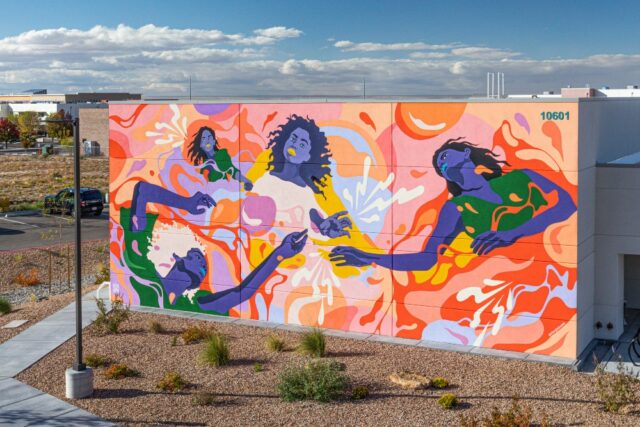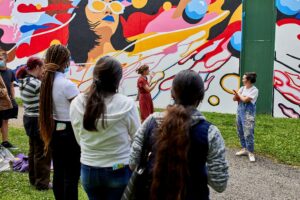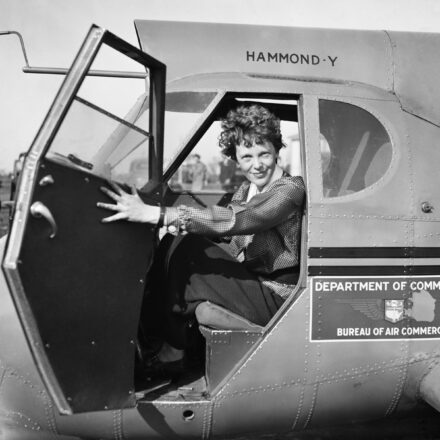Gretchen Menter remembers the day she and a colleague took a casual walk through Central Park in late 2016. She looked around and realized that she hadn’t seen one female statue—all the monuments around her were a bunch of “white dudes.” After a quick Google search back at the office, she learned that all of the statues in the park were of men, except for female literary figures, such as Shakespeare’s Juliet and Alice from “Alice in Wonderland.”
“I thought, That’s so weird, so then I started Googling statues in other places,” recalls Menter. She came across a staggering statistic: Approximately 93% of all statues in the U.S. were of men.
Menter—a creative director at advertising company VMLY&R—started to wonder why there weren’t more female statues and learned that the cost and red tape can be prohibitive, noting that “permits for the land are really hard to get” because Central Park is historically protected.
Menter brainstormed with her colleagues about what could be done. They wondered: What if you could build an app with augmented reality (AR) so that if you positioned your phone at one of the male statues in Central Park, you could have an influential woman from history pop up alongside them?
Two months later, the Whole Story app launched, doing just that. With 60 statues in 12 countries, the app was the start of a trend: Use AR to give a voice to women—even those who are long gone—by celebrating their accomplishments and making them more visible to current generations.
“It just seemed to be part of a cultural moment,” Menter says. “The thought that we had while we were walking through the park seemed to be a thought that I guess everybody was having at the time. You look around, and you start to become aware of all the places that there are holes, you know?”
Why are many women’s achievements an afterthought?
Many contributions from women have been lost to history, not just in terms of commemorative statues but in textbooks, as well. Studies show that the majority of references in history books are for men, not women. According to research conducted by The National Women’s History Museum, women and minorities are vastly underrepresented in U.S. history books, with one woman mentioned for every three men mentioned.
“Too many of our stories, especially the stories of women of color, have been lost to history and sexism, or just intentionally erased, which means that when young women are questioning whether or not they belong in a space, they just might not know that they’re part of the long legacy of women who have been and are continuing to shape our society,” says Amanda Phingbodhipakkiya, an artist inspired by feminism and science who often incorporates AR into her work.

Phingbodhipakkiya, who has a background in neuroscience, has long been perplexed by why women in STEM haven’t been recognized. In many of her projects, she aims to highlight their stories and “let folks know that there’s a long legacy of women in STEM that we just don’t know about.”
Bringing women back into the picture
While historical documents and statues are set in stone, AR is a way to bring women into the picture without changing history. Many history textbooks that are used in schools, for example, have stayed the same for a long time, but AR can change how a student experiences the book without actually modifying the book itself.
The Lessons in Herstory app, for example, uses AR so that when a student points her camera at a photo of a man in the history book, “A History of U.S.: Liberty for All? 1820-1860,” a woman will pop up in his place, such as Cathay Williams, Annie Oakley, Harriet Tubman and Lotta Crabtree, to name a few.

In addition, the Whole Story app used AR for “ground plane detection,” which relies on visual details in the environment to detect a user’s position. Steve Martell, a vice president at Current Studios who worked on the project, remembers the challenges the team faced when designing the app.
“At the time, there was nothing really available on a mobile device that allowed us to physically and consistently launch an AR experience without having a marker, something to look at, to say, This is the place to do it,” Martell says.
They needed to know where a user was standing when they were using the app, but they couldn’t just put a QR code near each statue in Central Park for users to scan, given that getting permission “would have taken forever,” he says.
The team designed the app to incorporate the geolocation of each male statue in the park so that when an app user was within 10 meters of the statue, the user’s phone camera turned on to detect the ground plane. Then, the user aimed their camera at the statue, and a 3D statue of a female counterpart would pop up, such as Amelia Earhart or Susan B. Anthony.
Behind the scenes, each female statue was built using Maya, a 3D-modeling software, then placed at the right GPS location. The team also created a feature in the app so that people around the world could submit their own statues for approval. If a user clicked on a button within the app to add their 3D statue, they were sent to a website where they could upload it and go to where they wanted the statue to be. When they hit a “submit” button, the app would pull in GPS data and imagery so that the team could add it to their list of approved locations.
“Now there are companies positioned in this technology, but at the time, it was still very new in the minds of the public and a first-ever use of the tech in that way,” Martell says. “So it was this idea of a public participatory platform—the ability to not disrupt the park but still have this ability to represent art and culture in a different way—that was easily accessible and could then be added to by people who didn’t need coding experience.”
Inspiring the next generation
These AR projects also inspire school-age girls to learn about real-world applications of STEM.
Phingbodhipakkiya partners with local high school and middle school students who have a particular interest in art, science and technology and invites them to come and help paint her 10 AR-enabled murals in her public art series Findings that highlights the work of women in STEM.
“Sometimes I’ll talk to them early on and let them know that we’re coming and explain a little bit more about the art and the story behind the mural and the technology, but oftentimes, I’m meeting them on-site, and they come out to paint for a few days and make a mark on the city that they call home,” she says.

On the user end, when someone scans a QR code embedded in one of her murals, they can download an app that explains more about the mural and the science behind it, as well as experience animations. A forthcoming update to the app will allow users to project the murals onto blank spaces in their home or classroom.
For The Whole Story app, the team enlisted Girls Who Code and had them teach a Girl Scouts troop how to make their own statues. “The girls actually went out and helped us place them,” says Menter, who hopes that a future iteration could contain a large database of female statues so that school children could place statues of women in their local parks.
“The girls were pumped to be placing the statues and were running from one place to the next,” Menter says. “They seemed to be already versed in the idea that, if you can’t see it, you can’t be it. I think they felt very excited to be part of the shift for future generations.”
Lead photo of Amelia Earhart in a Department of Commerce Airplane in 1936 courtesy of Everett Collection/Shutterstock.

